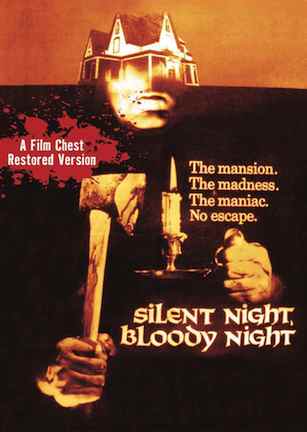Studio: Film Chest Media Group
Director: Theodore Gershuny
Writer: Theodore Gershuny, Jeffrey Konvitz, Ira Teller
Producer: Jeffrey Konvitz, Ami Artzi
Stars: Patrick O’Neal, James Patterson, Mary Woronov, Astrid Heeren, John Carradine, Walter Abel
Review Score:
Summary:
A small town is stalked by a mysterious murderer connected to an abandoned mansion that was once the site of an insane asylum.
Review:
“Silent Night, Bloody Night” is not as “Christmas-y” as its name would imply, which is likely at least one reason why it was initially released with the less seasonal title, “Night of the Dark Full Moon.” Without a killer Santa Claus or any plot-motivated holiday theme, the December setting is largely incidental, necessary mainly to justify snow on the ground. A carol or two can be heard in the background and one character is briefly seen wrapping presents, but the story could take place in June or July just the same.
Still, “Silent Night, Bloody Night” (“SNBN”) would make a perfect opening feature on a double bill with Bob Clark’s 1974 classic “Black Christmas” (review here). Even though the two films are unrelated as pure holiday horror, they share thematic elements in common as precursors to the late ‘70s, early ‘80s boom in slasher cinema.
There are those quick to raise an index finger and say “not so fast” to laud “Black Christmas” whenever John Carpenter’s “Halloween” (review here) is mentioned as a jumpstart to the genre. A similar case could be made for “SNBN” when referencing Clark’s film. Both films feature creepy phone calls, first person POV perspectives, twisted family trees, and outdated scenes involving phone bank switchboards as memorable hallmarks. Yet while “Black Christmas” became hailed as a contemporary classic, “SNBN” fell into public domain obscurity.
Among the reasons for that disparity is no doubt the fact that “Black Christmas” is a much more accessible film by mainstream scary movie standards. “Silent Night, Bloody Night” is an unusual mix of old dark house thriller, small town secret mystery, and ax-murdering mania from a time in slasher history when dramatic theatricality went beyond snarky one-liners and creative kills. It is continually engaging as a gradually unfolding horror whodunit, though it surely fails to grab some viewers because of that slow pace, and because its plot is probably more complicated than it needs to be.
The short summary is that in an effort to help his troubled daughter, Wilfred Butler welcomed doctors into his home and eventually turned his house into a mental asylum. Twenty years later, Butler returned to the house after a mysterious absence only to be set on fire and burned to death in a Christmas Eve incident ruled to be an accident. Twenty more years later, Butler’s grandson Jeffrey decides to sell the long abandoned house back to the town that wants it destroyed. But a mystery figure in the house going by the name “Marianne” has plans for the townspeople involving an ax and their true connection to the Butler house’s sinister past.
With various threads relayed via flashbacks, diary readings, newspaper narrations, and present day scenes spanning the 1930s, 1950s, and 1970s, “SNBN” already has plenty going on within its 84 minutes before introducing a cargo net bursting with red herrings. In addition to the identity of “Marianne,” the mystery of Wilfred Butler’s death, and the sudden reemergence of his grandson Jeffrey, there are also side stories involving a philandering estate attorney and an escaped inmate from a nearby mental hospital. Changing directions almost as much as it changes scenes, “SNBN” has a lot of story on the table, though not all of it adds up to a meaningful payoff in the end.
Regardless of its relative impact, “SNBN” is a film unafraid to take chances in its effort to stand out. Its cast alone is proof. Mary Woronov features prominently as just one of several Andy Warhol superstars making an onscreen appearance, although the others are bit cameos as asylum inmates and dinner guests. In a move that is either brilliant or baffling, “SNBN” takes film legend John Carradine, an actor partly known for his distinct voice, and makes him a mute who communicates by ringing a desk clerk’s bell. That’s just one Twin Peaks-like eccentricity assigned to the roster, another being a pillbox hat-wearing woman with no less than forty occupied birdcages populating her home. This is quirky behavior befitting a cast of characters where almost no one is who they say they are.
It’s a clichéd assessment to assign, but “Silent Night, Bloody Night” is a sign of its filmmaking times. Enjoyably odd performances and a story that is slow but never dull make for an interesting film, even if the overall execution is questionable. Tolerance for seventies cinematic stylings certainly helps, though “SNBN” does come up short in enough categories related to quality that it is understandable if it does not make the annual rotation of fright films to revisit every December.
NOTE: “Silent Night, Bloody Night” was also released under the titles “Night of the Dark Full Moon” and “Death House.”
Review Score: 65






It assumes everyone watching must be a dimwit too dense to understand how the most basic storytelling concepts work.